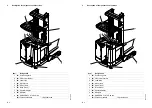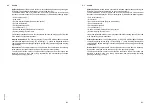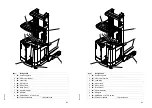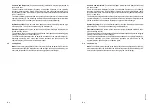
A 1
0
606
.USA
A Compliance with regulations -
Legislation and common sense
In 1998, OSHA produced a report on its wide-ranging study into the use of powered
industrial trucks in industry. This report was published in the
US Federal Register
/
vol. 63, no. 230. In this report OSHA sets out the many reasons why employers are
required to train their employees in connection with the use of powered industrial
trucks and why untrained personnel must be prohibited from using industrial trucks
except in controlled operating conditions such as a training session. The report shows
how
extremely important
a training program as required by the OSHA guidelines is
for the safety of equipment and personnel in connection with the use of powered
industrial trucks. 29 CFR part 1910.178. In simple terms, thorough training prior to the
use of an industrial truck is
extremely important
and
must
take place before an
industrial truck is used, since accidents leading to injury and death or property
damage are almost always the consequence of disregarding the underlying risks held
by the use of industrial trucks or of ignoring safety instructions and safety precautions
designed to minimize or eliminate such risks. The OSHA training program specifically
addresses these risks. The evidence contained in the OSHA report demonstrates that
the statutory training requirements for operators and employers are based on
experience and general judgment.
Jungheinrich industrial trucks satisfy the requirements of 29 CFR 1910.178 and
ASME B 56.1. Jungheinrich representatives are always on hand to provide advice on
issues surrounding the loading, operation, use and maintenance of powered
industrial trucks.
According to the OSHA report, knowledge and skills to operate an industrial truck
powered by an electric drive are not innate in human beings. Quite the contrary: This
knowledge can only be acquired through theoretical and practical training. This
means that having an industrial truck that complies with statutory regulations and
standards, is only one half of the safety equation. It is up to you, the operator, and
your employer to be aware of your responsibilities and of all national and regional
regulations and laws governing training requirements and the safe use of powered
industrial trucks, not only because the law requires it but because it is a matter of
common sense.
Powered industrial trucks may only be operated by trained and tested persons.
Training programs must satisfy OSHA requirements and as a minimum
address the topics mentioned here.
Employers and operators should pay especial attention to the section in ASME
regulations B56.1 concerning the operator.
"Safe operation is the responsibility of the operator" ASME B56.1 -2004, Part II
Section 5.1.1.
A 1
0
606
.USA
A Compliance with regulations -
Legislation and common sense
In 1998, OSHA produced a report on its wide-ranging study into the use of powered
industrial trucks in industry. This report was published in the
US Federal Register
/
vol. 63, no. 230. In this report OSHA sets out the many reasons why employers are
required to train their employees in connection with the use of powered industrial
trucks and why untrained personnel must be prohibited from using industrial trucks
except in controlled operating conditions such as a training session. The report shows
how
extremely important
a training program as required by the OSHA guidelines is
for the safety of equipment and personnel in connection with the use of powered
industrial trucks. 29 CFR part 1910.178. In simple terms, thorough training prior to the
use of an industrial truck is
extremely important
and
must
take place before an
industrial truck is used, since accidents leading to injury and death or property
damage are almost always the consequence of disregarding the underlying risks held
by the use of industrial trucks or of ignoring safety instructions and safety precautions
designed to minimize or eliminate such risks. The OSHA training program specifically
addresses these risks. The evidence contained in the OSHA report demonstrates that
the statutory training requirements for operators and employers are based on
experience and general judgment.
Jungheinrich industrial trucks satisfy the requirements of 29 CFR 1910.178 and
ASME B 56.1. Jungheinrich representatives are always on hand to provide advice on
issues surrounding the loading, operation, use and maintenance of powered
industrial trucks.
According to the OSHA report, knowledge and skills to operate an industrial truck
powered by an electric drive are not innate in human beings. Quite the contrary: This
knowledge can only be acquired through theoretical and practical training. This
means that having an industrial truck that complies with statutory regulations and
standards, is only one half of the safety equation. It is up to you, the operator, and
your employer to be aware of your responsibilities and of all national and regional
regulations and laws governing training requirements and the safe use of powered
industrial trucks, not only because the law requires it but because it is a matter of
common sense.
Powered industrial trucks may only be operated by trained and tested persons.
Training programs must satisfy OSHA requirements and as a minimum
address the topics mentioned here.
Employers and operators should pay especial attention to the section in ASME
regulations B56.1 concerning the operator.
"Safe operation is the responsibility of the operator" ASME B56.1 -2004, Part II
Section 5.1.1.
Summary of Contents for ETR 314
Page 1: ...Operating instructions 50 452 907 ETR 314 320 u 06 06 11 09 07 08 E Manual de instrucciones...
Page 7: ...0608 USA I 4 0608 USA I 4...
Page 9: ...0606 USA A 2 0606 USA A 2...
Page 24: ...D 9 0107 USA D 9 0107 USA...
Page 26: ...D 11 0107 USA D 11 0107 USA...
Page 103: ...0107 USA F 10 0107 USA F 10...
Page 123: ...0708 USA G 20 0708 USA G 20...
Page 135: ...0608 E I 4 0608 E I 4...
Page 137: ...0606 E A 2 0606 E A 2...
Page 152: ...D 9 0107 E D 9 0107 E...
Page 154: ...D 11 0107 E D 11 0107 E...
Page 225: ...0608 E E 66 0608 E E 66...
Page 235: ...0107 E F 10 0107 E F 10...
Page 255: ...0708 E G 20 0708 E G 20...



































